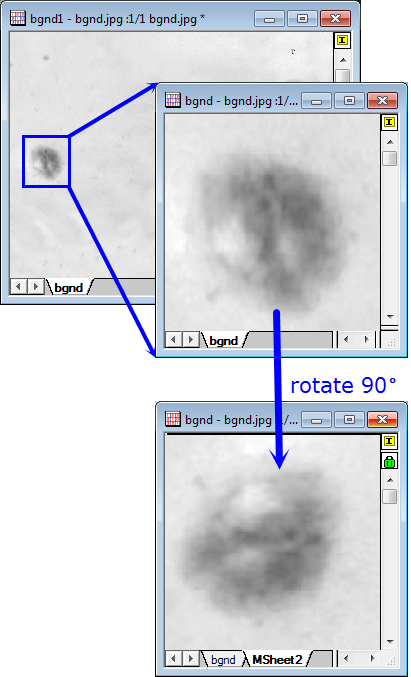Image Processing
Origin offers a collection of easy-to-use tools for your general Image Processing needs.
The tools provide an intuitive interface with the option to save custom settings as a dialog theme for repeat use.
Most tools also provide a preview window of results based on current dialog settings.
The Image Processing tools are broadly organized in the following categories:
Image Adjustment
Origin's image adjustment tools include level, contrast, gamma, hue, saturation, and brightness modification. These tools can be used for tasks such as fixing overexposure, correcting color, and improving brightness. Image adjustment can facilitate other advanced image processing tasks, such as improved edge detection that may result from contrast improvement.
Origin provides the following easy-to-use tools for image adjustment:
- Brightness
- Contrast
- Gamma
- Hue
- Invert
- Saturation
- Histcontrast
- Histequalize
- Auto Level
- Color Level
- Function Look Up Table PRO
- Leveling PRO
- Balance
- Color Replace

The original image and the results of brightness adjustment. The second image is generated by increasing the brightness while the third one decreasing the brightness. Brightness adjustment shifts every pixel by a constant (positive or negative) without changing the distribution.
Arithmetic Transforms
Arithmetic transformation is a class of pixel-by-pixel arithmetic operations performed on one or two images.
Origin supports the following Arithmetic Transformation operations:
- Alpha Blend PRO
- Extract to XYZ PRO
- Image Simple Math PRO
- Math Function PRO
- Morphological Filter PRO
- Pixel Logic PRO
- Replace Background PRO
- Subtract Background PRO
- Subtract Interpolated Background PRO
Alpha blending is useful to create transparent effects, which can be used to render glass or liquid objects in computer graphics. Another use of alpha blending is adding visual objects to a background image.
Image simple math includes operations such as addition, subtraction, multiplication and averaging, of two images.
In math function and pixel logic, the output image is a pixel-to-pixel mapping of the input image. These tools can be used for extracting, emphasizing or suppressing some features of the image.
The "Subtract Background" tool is designed for background removal when the background image is not available.
Image Conversion
Image conversion generally includes converting a color image to a gray or binary, switching between image and data, splitting and merging the RGB color channels, and using the image palette to apply pseudo color to a gray scale image.
Origin provides following image conversion tools:
- Convert Image to Data
- Convert Color Image to Grayscale
- Convert Data to Image
- Auto Binary
- Binary
- Dynamic Binary PRO
- Threshold PRO
- RGB Merge / RGB Split PRO
- Image Scale PRO
- Image Palette
Geometric Transforms
Geometric transformation is a class of operations that alter the spatial relationships between the pixels in an image. These operations can be used to improve the appearance of images.
Origin supports the following Geometric Transforms operations:
- Auto Trim
- Crop
- Flip
- Offset
- Resize
- Rotation
- Shear
The resize tool helps to change the aspect ratio, reduce the size of the image or amplify details.
Rotation and shearing can be useful pre-processing routines for applications where directional operators (such as directional edge detection) are applied.
Trimming and cropping removes unwanted areas from the image.
Image offset helps to align two images so as to facilitate operations such as background subtraction.

Cropping the image helps to focus on the interested part. The image is then rotated it by 90 degree. Other geometric transforms include flipping, shearing, resizing and moving with an offset.
Spatial Filters
Spatial filters are designed to highlight or suppress features in an image based on spatial frequency, such as suppressing 'noise' or highlighting specific image characteristics.
In Origin, several spatial filtering routines are available:
- Average
- Clear
- Edge
- Gaussian
- Median
- Noise
- Sharpen
- Unsharp Mask
- User Filter PRO
Gaussian filtering is most suitable for removing Gaussian noise. For salt-and-pepper, or shot noise, median filter works best. Average filter is a simple case of Gaussian filtering. These filters can also be used for blurring images.
Sharpen and Unsharp Mask enhance the edges and details in the image.
Edge detection aids in finding boundaries of the objects in an image.

Four images from top to bottom showing the original image, applying a average filter on it to blur the image by replacing each pixel by the average of pixels in its neighborhood, sharpening it, and applying a unsharp mask on it to emphasizing the edges and details of cells by identifying pixels that are different from neighboring pixels and increasing their contrast.